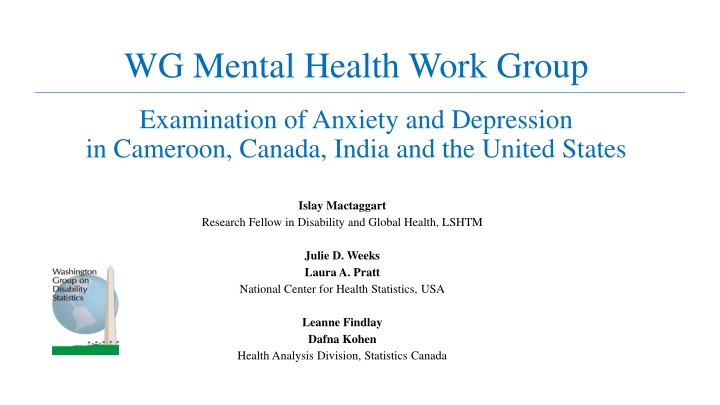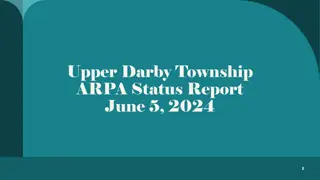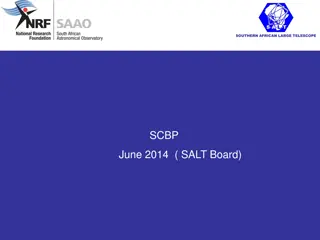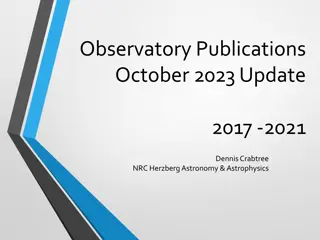6m Telescope for the South Pole: Status Report and Funding Update
This status report from the 2018 Florence CMB Coordination Meeting discusses the motivations behind the initiative, the current funding status, and the potential European coordination for the CMB-S4 Collaboration. It highlights the scientific advances and partnerships involved in the development of a next-generation 6m wide-field survey telescope for the South Pole.
Download Presentation

Please find below an Image/Link to download the presentation.
The content on the website is provided AS IS for your information and personal use only. It may not be sold, licensed, or shared on other websites without obtaining consent from the author.If you encounter any issues during the download, it is possible that the publisher has removed the file from their server.
You are allowed to download the files provided on this website for personal or commercial use, subject to the condition that they are used lawfully. All files are the property of their respective owners.
The content on the website is provided AS IS for your information and personal use only. It may not be sold, licensed, or shared on other websites without obtaining consent from the author.
E N D
Presentation Transcript
WG Mental Health Work Group Examination of Anxiety and Depression in Cameroon, Canada, India and the United States Islay Mactaggart Research Fellow in Disability and Global Health, LSHTM Julie D. Weeks Laura A. Pratt National Center for Health Statistics, USA Leanne Findlay Dafna Kohen Health Analysis Division, Statistics Canada
Presentation Outline WG Mental Health Working Group data analysis goals Reminder of WG ES-F affect questions Methods and data used Measures employed Results Recommendations for next steps
Mental Health Work Group Goals Can the WG affect questions be used to determine prevalence of poor mental health in comparison to other validated tools? Can the WG affect questions be used to indicate poorer functioning due to poor mental health?
WG Extended Set Affect Questions: Depression 1. How often do you feel depressed? Daily / Weekly / Monthly / A few times a year / Never 2. Do you take medication for these feelings? Yes / No 3. Thinking about the last time you felt depressed, how depressed did you feel? A little / A lot / Somewhere in between a little and a lot
WG Extended Set Affect Questions: Anxiety 1. How often do you feel worried, nervous or anxious? Daily / Weekly / Monthly / A few times a year / Never 2. Do you take medication for these feelings? Yes / No 3. Thinking about the last time you felt worried, nervous or anxious, how would you describe the level of these feelings? A little / A lot / Somewhere in between a little and a lot
Methods Secondary data analysis of three datasets: U.S.: National Health Interview Survey (2012) Cameroon (2013) and India (2014): ICED Building the Evidence Survey Canada: Canadian Community Health Survey Mental Health (2012) Use of other known tools to measure mental health: Kessler 6 (K6) Patient Health Questionnaire (PHQ-9)
Datasets: U.S. The National Health Interview Survey Nationally representative household interview survey designed to produce estimates of the health of the U.S. civilian noninstitutionalized population. In-person interviews in the respondent s home Sample size: 34,525 Response rate: 61.2% Mental health content: WG Affect and K6 Self-report Persons age 18 and over
Datasets: Cameroon and India The ICED Building the Evidence in Disability Study Two-country district level population based survey of disability in Mahbubnagar District, Telengana State (India) and Fundong Distring, North West Cameroon. In-person interviews in central village location Sample size: 4,056 all-age sample per country Response rate: 87% in Cameroon / 88% in India Mental health content: WG Affect and PHQ-9 Self-report Persons age 18 and over
Datasets: Canada Canadian Community Health Survey Mental Health Population-based household survey of residents aged 15 or older in ten provinces excluding reserves, full-time members of Canadian Forces and institutionalised population. In-person interviews in the respondent s home and telephone interviews Sample size: 25,113 Response rate: 68.9% Mental health content: K6 and questions on depression, anxiety ( WG proxy ) Self-report Persons age 18 and over
Kessler 6 (USA, Canada) A six-question scale designed to identify persons with serious psychological distress. Now I am going to ask you some questions about feelings you may have experienced over the PAST 30 DAYS. DURING THE PAST 30 DAYS, how often did you feel: 1. So sad that nothing could cheer you up? 2. Nervous? 3. Restless or fidgety? 4. Hopeless? 5. That everything was an effort? 6. Worthless? Response categories: ALL of the time / MOST of the time / SOME of the time / A LITTLE of the time / NONE of the time Score ranges from 0-24. A score of 13+ indicates serious psychological distress (SPD) and a high likelihood of a diagnosable DSM disorder (Kessler, 2003).
PHQ-9 (India, Cameroon) PHQ-9 Properties Patient Health Questionnaire (PHQ-9) Screening and diagnosis of depression 3 Screening questions followed by 6 further questions if screen positive to probe Score ranges from 0-27 Score 15-19 major depression moderately severe Score 20+ major depression, severe
WG Proxy Affect Questions (Canada) Anxiety Did you ever have a period lasting 6 months or longer when you were anxious and worried most days? Yes, no How much emotional distress did you ever experience because you felt these (generalized anxiety disorder) symptoms? Very severe, severe, moderate, mild, none Depression During the past month, about how often did you feel sad or depressed? All of the time, most of the time, some of the time, a little of the time, none of the time During the past month, about how often did you feel so depressed that nothing could cheer you up? All of the time, most of the time, some of the time, a little of the time, none of the time
Construction of a single variable each for WG anxiety and WG depression
Methods WG Affect Variable Composition Depression & Anxiety 4 category variable for each, combining frequency and intensity (USA, Cameroon and India only) Frequency Daily Frequency A little In Between A lot Weekly Monthly Few x/yr Never Intensity High Medium Medication not included in variable due to differences in access across settings Low None
Methods Canada WG Proxy Depression Variable Composition 4 category variable combining frequency and intensity Frequency All of the time Most of the time Some of the time A little of the time None of the time Intensity None Mild Moderate Severe Very severe High Medium Low None
Method MCanada WG Proxy Anxiety Variable Composition 4 category variable combining occurrence and intensity Yes No Intensity None Mild Moderate Severe Very severe High Medium Low None
Population prevalence of affect disorder - USA and psychological distress, USA Population prevalence of anxiety, depression Percent 90 Similar trends across tools but proportions higher using WG 80 70 60 50 40 30 20 10 0 None LowMedium High None Low Medium High 0-4 5-7 8-12 SPD 13+ WG Anxiety WG Depression Psychological distress (K6)
Population prevalence of affect disorder - Canada Population prevalence of WG proxy anxiety and depression, psychological distress, Canada 90.0 Less clear trends using WG proxy compared with K6 80.0 70.0 60.0 50.0 40.0 30.0 20.0 10.0 0.0 None Low Medium High None Low Medium High 0-4 5-7 8-12 SPD 13+ WG proxy Anxiety WG proxy Depression Psychological distress (K6) Source: Canadian Community Health Survey, Mental Health (2012)
Population prevalence of affect disorder Cameroon and India depressive symptoms, Cameroon and India Population prevalence of anxiety, depression and 90 Similar trends across tools but WG higher than PHQ-9 80 70 60 50 40 30 20 10 0 None Low Medium High None Low Medium High None Mild Moderate Mod. severe Severe WG Anxiety WG Depression PHQ Cameroon India
Cross country prevalence of WG/WG proxy affect disorder proxy anxiety and depression Cross country prevalence of WG and WG 90 Variation across countries in none/low/medium but similar at high level 80 70 60 50 40 30 20 10 0 None Low Medium High None Low Medium High WG Anxiety WG Depression Canada USA Cameroon India
Comorbidity of WG anxiety and WG depression in USA Comorbidity of WG anxiety and depression, USA Level of Depression High correlation of level of anxiety amongst those with any level of depression lower amongst those with any level of anxiety Level of Anxiety 100% 90% 80% 70% 60% None Low 50% Medium 40% High 30% 20% 10% 0% High Medium Low None High Medium Low None
Comorbidity of WG anxiety and WG depression in India Comorbidity of WG proxy anxiety and depression, Canada Level of Depression Medium correlation of level of anxiety amongst those with any level of depression lower amongst those with any level of anxiety Level of Anxiety 100 90 80 70 60 None Low 50 Medium 40 High 30 20 10 0 High Medium Low None High Medium Low None Source: Canadian Community Health Survey, Mental Health (2012)
Comorbidity of WG anxiety and WG depression in Cameroon Comorbidity of WG anxiety and depression, Cameroon Level of Depression Medium correlation between both groups but some high levels depression amongst low levels anxiety and vice versa Level of Anxiety 100% 90% 80% 70% 60% 50% 40% 30% 20% 10% 0% High Medium Low None High Medium Low None Level of Depression Level of Anxiety High Medium Low None
Comorbidity of WG anxiety and WG depression in India Comorbidity of WG anxiety and depression, India Level of Depression High correlation between both groups but some high levels depression amongst low levels anxiety and vice versa Level of Anxiety 100% 90% 80% 70% 60% 50% 40% 30% 20% 10% 0% High Medium Low None High Medium Low None Level of Depression Level of Anxiety High Medium Low None
Can the WG affect questions be used to determine prevalence of poor mental health in comparison to other validated tools?
K6 score category (0-4, 5-7,8-12,13+) by level of depression and anxiety, USA High levels of depression or anxiety associated with higher scores on K6 Percent with each level 100% 90% 80% 70% 0-4 60% 5-7 50% 8-12 40% 13+ 30% 20% 10% 0% High Medium Low None High Medium Low None Level of Depression Level of Anxiety
K6 score category (0-4, 5-7,8-12,13+) by level of depression and anxiety, Canada High levels of depression strongly associated with higher scores on K6 anxiety less clear Percent with each level 100.0 90.0 80.0 70.0 60.0 0-4 50.0 5-7 8-12 40.0 SPD 13+ 30.0 20.0 10.0 0.0 High Medium Low None High Medium Low None Level of depression Level of anxiety Source: Canadian Community Health Survey, Mental Health (2012)
PHQ-9 score by level of depression and anxiety, Cameroon 100% Associations less clear high levels of anxiety or depression still associated to none/mild in PHQ-9 90% 80% 70% 60% 50% 40% 30% 20% 10% 0% High Medium Low None High Medium Low None Level of Depression Level of Anxiety Severe Moderately Severe Moderate Mild None
PHQ-9 score by level of depression and anxiety, India 100% Associations less clear high levels of anxiety or depression still associated to none/mild in PHQ-9 80% 60% 40% 20% 0% High Medium Low None High Medium Low None Level of Depression Level of Anxiety Severe Moderately Severe Moderate Mild None
Can the WG affect questions be used to indicate poorer functioning due to poor mental health?
Percentage of respondents with no, some or a lot of difficulty remembering or concentrating by level of anxiety or depression, USA Higher difficulties remembering/concentrating with increasing symptoms of anxiety/depression Percent No difficulty Some difficulty A lot of difficulty 100 90 80 70 60 50 40 30 20 10 0 High Medium Low None High Medium Low None Anxiety Depression
Percentage of respondents reporting each frequency of pain by level of anxiety or depression, USA More frequent experience of pain with increasing symptoms of anxiety/depression Percent None Some Days Most Days Every day 70 60 50 40 30 20 10 0 High Medium Low None High Medium Low None Anxiety Depression
Percentage of respondents reporting each frequency of feeling tired or exhausted by level of anxiety or depression, USA More frequent experience of fatigue with increasing symptoms of anxiety/depression Percent Never Some Days Most Days Every day 70 60 50 40 30 20 10 0 High Medium Low None High Medium Low None Anxiety Depression
Percentage of respondents with no, some or a lot of difficulty concentrating by level of anxiety or depression, Canada Higher difficulties remembering/concentrating with increasing symptoms of anxiety/depression No difficulty Some difficulty A lot of difficulty Percent 100.0 90.0 80.0 70.0 60.0 50.0 40.0 30.0 20.0 10.0 0.0 High Medium Low None High Medium Low None Anxiety Depression Source: Canadian Community Health Survey, Mental Health (2012)
Percentage of respondents reporting degree of interference due to pain by level of anxiety or depression, Canada Percent More frequent experience of pain with increasing symptoms of anxiety/depression 90 80 70 60 50 40 30 20 10 0 High Medium Low None High Medium Low None Anxiety Depression No pain or discomfort Pain prevents no activities Pain prevents a few activities Pain prevents some activities Pain prevents most activities Source: Canadian Community Health Survey, Mental Health (2012)
Percentage of respondents with no, some or a lot of difficulty remembering or concentrating by level of anxiety or depression, Cameroon and India Higher difficulties remembering/concentrating with increasing symptoms of anxiety/depression India Cameroon 100 80 90 70 80 60 70 50 60 40 50 30 40 30 20 20 10 10 0 0 None Medium Medium Low Low High High None Low Low High Medium High Medium None None Level of Depression Level of Anxiety Level of Depression No difficulty Level of Anxiety A lot of difficulty/cant do No difficulty Some difficulty A lot of difficulty/cant do Some difficulty
Percentage of respondents reporting each frequency of pain by level of anxiety or depression, Cameroon and India More frequent experience of pain with increasing symptoms of anxiety/depression Cameroon India 100% 100% 90% 90% 80% 80% 70% 70% 60% 60% 50% 50% 40% 40% 30% 30% 20% 10% 20% 0% 10% Medium Medium Low None Low None High High 0% High Medium Low None High Medium Low None Level of Depression Level of Anxiety Level of Depression Level of Anxiety Every Day Most Days Some Days Never Every Day Most Days Some Days Never
Percentage of respondents reporting each frequency of feeling tired or exhausted by level of anxiety or depression, Cameroon and India More frequent experience of fatigue with increasing symptoms of anxiety/depression Cameroon India 100% 100% 90% 90% 80% 80% 70% 70% 60% 60% 50% 50% 40% 40% 30% 30% 20% 20% 10% 10% 0% 0% Low Medium Low None None Medium High High Low Medium Low Medium None None High High Level of Depression Level of Anxiety Level of Depression Level of Anxiety Every Day Most Days Some Days Never
Summary In USA, Canada, Cameroon and India the 4 category variable for anxiety and depression identifies higher proportions having any level of symptoms of psychological distress than the K6 and PHQ 9, respectively. The K6 and the PHQ-9 are meant to pick up diagnosable disorders. The WG anxiety and depression questions may pick up sub-syndromal mental health issues as well, and the literature has shown that sub-syndromal issues contribute to difficulties in functioning. The K-6 and PHQ-9 use more restrictive time scales than the WG Prevalence of the 4 levels of the WG anxiety and depression variables differ from country to country, however these are similar at the highest level of symptoms In the NHIS and CCHS-MH, the 4-level WG anxiety and depression variables are associated with K6 scores but the PHQ-9 is less well associated with WG anxiety and depression as this is a more restrictive tool.
Summary, continued Comorbidity between WG anxiety and depression shows the patterns reported in the literature, namely that there is a high degree of comorbidity and that the percent of people with depression who also have anxiety is larger than the percent of people with anxiety who also have depression. Persons with high levels of the WG affect questions also have difficulty concentrating and remembering, and frequent pain and tiredness. These relationships are also seen in the literature.
Next Steps and Recommendations from WG Next Steps: Evaluate performance of affect questions Examine each item within the two domains Further comparisons across country data Further comparisons with other tools or screeners Examine a single affect indicator Recommendations from the WG?


![get⚡[PDF]❤ The Hubble Space Telescope: From Concept to Success (Springer Praxis](/thumb/21514/get-pdf-the-hubble-space-telescope-from-concept-to-success-springer-praxis.jpg)




















